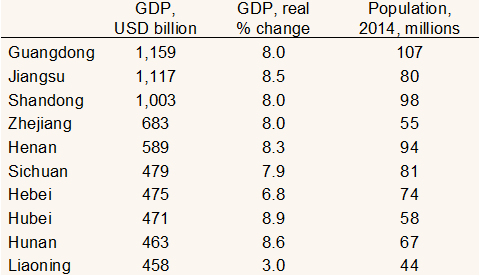BOFIT Weekly Review 11/2016
China’s largest provinces have economies similar in size to mid-sized emerging economies
The relative size of China’s provincial economies has increased dramatically in recent years due to economic growth well above that of many countries and the appreciation of yuan. Measured by nominal gross domestic product, China’s largest province Guangdong has an economy roughly equivalent in size to Mexico’s and only slightly smaller than the Russian economy (which has seen its GDP in dollars fall substantially on recession and the ruble’s collapse). China’s second and third largest provinces, Jiangsu and Shandong, each boast economies larger than that of Indonesia’s. Three largest provinces, however, are in a class of their own in Chinese terms and the differences across other provinces are huge. In terms of GDP, Tibet has the smallest and poorest economy. It is only about 1 % of the size of the Guangdong economy.
The fastest economic growth in recent years has been posted by the Chongqing, Tibet and Guizhou provinces (all posted annual economic gains above 10 % last year). In contrast, growth has slowed significantly in provinces traditionally known for heavy industry. The Shanxi and Liaoning provinces posted the lowest growth last year, just 3 %. Their futures are hardly rosy either. Both have major production in overcapacity industries, which the central government is planning to close in coming years. Understandably, provincial governments vigorously oppose shuttering plants.
Chinese provincial-level statistical data should be treated with the great caution. Even if provinces have lowered their growth targets, very few have actually managed to achieve their growth targets in recent years. Moreover, most provinces likely fudge their figures, because economic performance remains a determinant of career advancement for provincial leaders. For this reason, the National Bureau of Statistics conducts its own studies to determine the extent of error in the data reported by provincial authorities in order to adjust national figures accordingly. Based on province-level data, for example, the Chinese economy last year grew by about 8 %, or 1 percentage point more than reported in the national figures. The size of the Chinese economy based on the figures provided by the 31 regions would have also been 7 % larger than GDP as reported by the NBS.
China’s ten largest provinces in 2015

Sources: CEIC and China National Bureau of Statistics